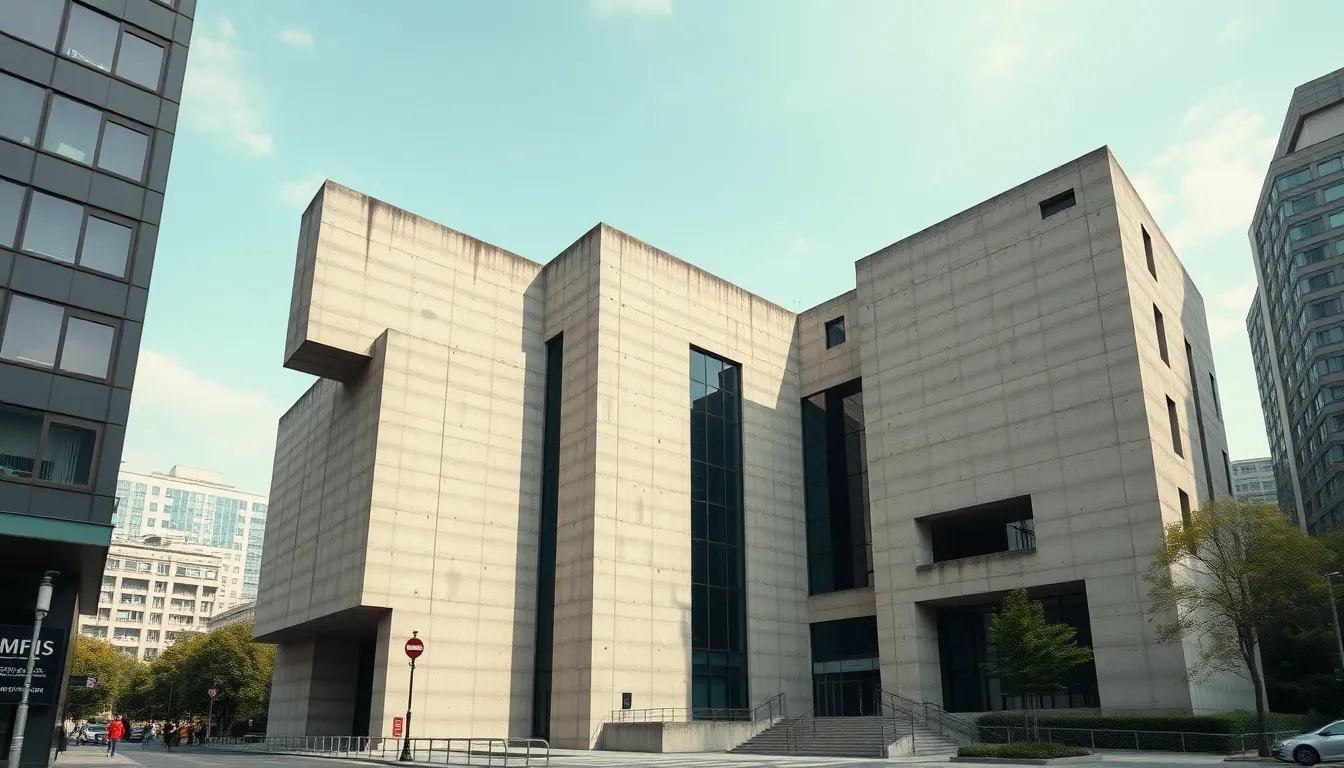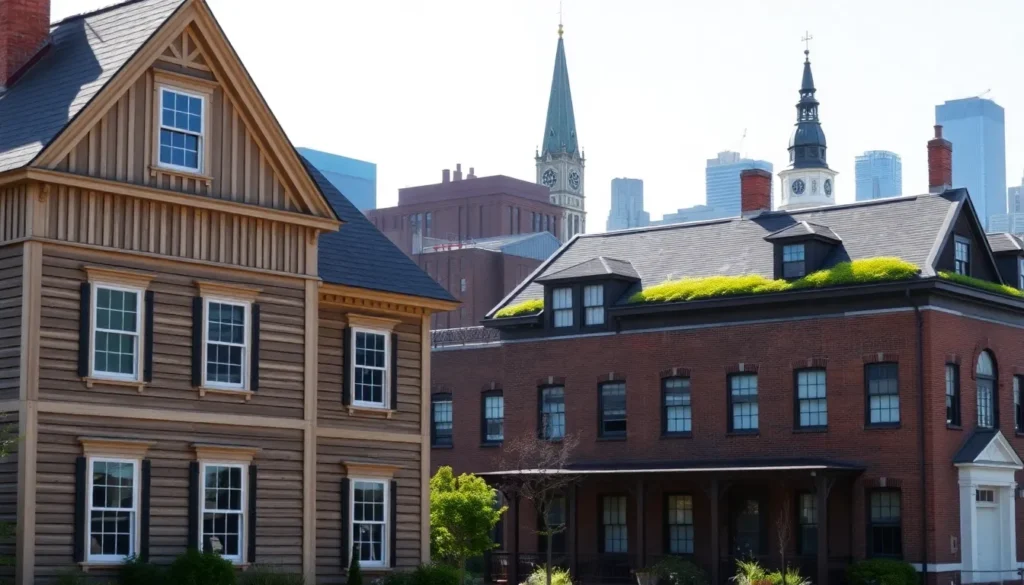Table of Contents
ToggleBrutalist architecture isn’t just a style; it’s a bold statement. Imagine concrete structures that look like they’ve been plucked straight from a sci-fi movie set. With their rugged lines and raw materials, these buildings scream, “I’m here, and I mean business!” While some might argue they resemble a parking garage gone rogue, others embrace their unapologetic charm and functionality.
This architectural movement, born in the mid-20th century, challenges conventional beauty and dares to be different. It’s the rebellious teenager of the design world, refusing to conform to pretty facades and instead showcasing strength and honesty. So, whether you love it or loathe it, one thing’s for sure: brutalism is here to stay, capturing the hearts of those who appreciate its unique character. Buckle up as we dive into the fascinating world of brutalist architecture and uncover what makes it so captivating.
Overview of Brutalist Architecture
Brutalist architecture emerged in the mid-20th century, originally rooted in modernism. This style emphasizes raw materials, primarily concrete, reflecting a stark and utilitarian aesthetic. Many densely urban areas feature these imposing structures. Architects like Le Corbusier and Louis Kahn significantly influenced its development.
Forms in brutalism are characterized by geometric shapes and bold lines. Large, solid volumes create a sense of strength and permanence. These buildings often lack decorative elements, making functionality the priority. Notable examples include the Boston City Hall and the National Theatre in London.
Critics frequently express mixed feelings about brutalism. Some individuals describe it as cold and unwelcoming. Others find a unique beauty in its rugged simplicity. Proponents argue its design fosters community and social interaction, aiming to connect people through shared spaces.
Brutalism’s significance also extends beyond aesthetics. It embodies an ideological statement about architecture’s role in society. Many structures from this movement prioritize functionality over form, reflecting values of the post-war era. It serves as a reminder of the architectural experimentation that occurred during the 20th century.
Numerous cities showcase brutalist buildings that are now considered cultural landmarks. Often these structures provoke discussion about urban planning and architectural legacy. Advocates continue to campaign for the preservation of these sites, recognizing their historical relevance and artistry.
Key Characteristics

Brutalist architecture stands out due to its unique characteristics that blend form and function. Key elements include material usage and design principles, both of which define this iconic style.
Material Usage
Concrete serves as the primary material in brutalist architecture. It emphasizes raw finishes that showcase the texture and imperfections of the material. Steel often appears alongside concrete, adding structural support while enhancing visual contrast. The use of glass in limited quantities conveys transparency and lightness against heavy concrete forms. These materials create a sense of durability and permanence, which aligns with the architectural ethos of strength and functionality.
Design Principles
Geometric shapes dominate the design landscape of brutalism. Large, angular forms create bold, striking silhouettes that command attention. Asymmetry often plays a crucial role, allowing for innovative configurations that challenge conventional aesthetics. Open floor plans promote functional use of space, encouraging social interactions. The unadorned, utilitarian design reflects a commitment to authenticity and practicality, situating brutalist structures firmly within their urban environments.
Historical Context
Brutalist architecture emerged in the mid-20th century, evolving from modernism. This movement was influenced by earlier styles, notably the Bauhaus and Le Corbusier’s principles focused on functionality and simplicity.
Origins and Influences
Architects like Louis Kahn and Moshe Safdie played pivotal roles in shaping brutalism. The post-World War II environment prompted a shift toward economical building methods and materials. Concrete became the primary material, reflecting a desire for functionality and social responsibility. Reactions against ornate styles further solidified brutalism as a method for expressing utilitarian ideals. Inspired by socialist principles, this architecture aimed to serve the public, emphasizing communal spaces.
Notable Examples
Boston City Hall exemplifies brutalism with its bold façade and massive concrete forms. The National Theatre in London stands out for its dramatic scale and innovative use of space. Montreal’s Habitat 67, designed by Moshe Safdie, showcases modular components that marry function with aesthetics. Each of these structures illustrates the commitment to raw materials and geometric shapes that define the movement. Other important examples include the Birmingham Central Library and the Yale Art and Architecture Building, both notable for their striking designs and urban relevance.
Criticism and Controversy
Brutalist architecture often sparks debate due to its striking aesthetics and social implications. Critics frequently describe it as stark and uninviting, viewing the raw concrete exteriors as bleak or oppressive. Some express disdain for the absence of ornamentation, believing beauty should encompass more than mere functionality. Supporters counter these claims by highlighting how its bold shapes and strong lines foster a sense of community. They emphasize that many brutalist buildings, while imposing, encourage social interaction and public engagement.
Public Perception
Public perception of brutalism varies widely. Many urban dwellers view these structures as eyesores that detract from cityscapes. Others appreciate them as artistic statements that challenge conventional architectural norms. Architects and design enthusiasts often admire the movement for its commitment to authenticity and material honesty. Additionally, younger generations may feel drawn to the retro-futuristic elements the style presents. Overall, opinions continue to evolve, reflecting a growing interest in exploring and reassessing brutalist structures.
Preservation Efforts
Preservation efforts for brutalist architecture have gained momentum in recent years. Advocacy groups and cultural organizations actively campaign for the protection of these significant landmarks. Many argue that preserving these buildings honors the innovative spirit of post-war architecture. Successful campaigns often include reaching out to local communities and engaging public interest. Some cities have designated brutalist structures as heritage sites, recognizing their historical value. As attitudes shift, it’s essential to consider how preservation can balance modernization with the need for architectural diversity.
Contemporary Relevance
Brutalist architecture continues to influence modern design and urban landscapes. This distinctive style captures attention, often blending seamlessly into contemporary settings.
Revival in Modern Design
Brutalism experiences a resurgence in today’s architectural scene. Many designers embrace its raw aesthetic, opting for concrete and bold geometric forms. New projects frequently incorporate brutalist principles, reflecting a fascination with minimalism and functionality. Examples like the Les Arcades shopping center in France demonstrate this revived interest, showcasing how brutalist elements harmonize with modern designs. Architects draw inspiration from classic brutalist structures while adding innovative twists, forging a connection between past and present.
Brutalism in Urban Planning
Brutalist design significantly impacts urban planning discussions. Many planners admire its potential to create communal spaces, encouraging social interactions among residents. Cityscapes increasingly feature brutalist buildings as focal points, promoting engagement and use of shared areas. Structures such as the Barbican Centre in London illustrate how these designs integrate community needs. Additionally, the continued advocacy for preserving existing brutalist architecture reinforces its value in urban identities, sparking dialogues on architectural heritage and future development.
Brutalist architecture stands as a testament to the boldness and innovation of mid-20th century design. Its raw materials and striking geometric forms challenge traditional aesthetics while offering a unique perspective on functionality and community. As urban landscapes evolve, the conversation around brutalism continues to grow, highlighting its significance in architectural history and modern design. Advocates for preservation recognize its cultural importance, ensuring that these iconic structures remain part of the urban fabric. With a resurgence in interest, brutalism is not just a relic of the past but a relevant force shaping contemporary architecture and urban planning.


